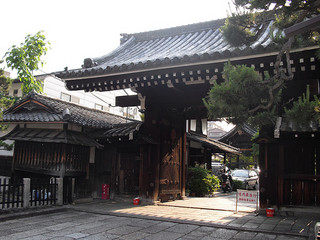Difference between revisions of "Honryu-ji"
| Line 6: | Line 6: | ||
Honryû-ji is one of eight head temples of the Shinmon school of the [[Hokke sect]] in [[Kyoto]]. It was established in [[1488]] by [[Nichishin]], a follower of [[Nichiren]], at Shijô-Ômiya. | Honryû-ji is one of eight head temples of the Shinmon school of the [[Hokke sect]] in [[Kyoto]]. It was established in [[1488]] by [[Nichishin]], a follower of [[Nichiren]], at Shijô-Ômiya. | ||
| − | The temple was destroyed in the early years of the [[Tenbun era]] (1532-1554), when the Hokke sect came under attack, but was rebuilt at its current location in [[1542]]. Much of the neighboring area was destroyed in fires in [[1730]] and [[1788]], but Honryû-ji miraculously survived, and has since been known as ''Yakezu-no-tera'' ("unburnable temple"). | + | The temple was destroyed in the early years of the [[Tenbun era]] (1532-1554), when the Hokke sect came under attack, but was rebuilt at its current location in [[1542]]. Much of the neighboring area was destroyed in fires in [[1730]] and [[Great Tenmei Fire|1788]], but Honryû-ji miraculously survived, and has since been known as ''Yakezu-no-tera'' ("unburnable temple"). |
Honryû-ji's grounds include Chiyo-no-i, one of the five clear water wells of [[Nishijin]]; a pine tree that is believed to keep babies from crying; and eight [[tatchu|sub-temples]]. The temple's treasures include a [[mandala]] said to have been painted by Nichiren himself. | Honryû-ji's grounds include Chiyo-no-i, one of the five clear water wells of [[Nishijin]]; a pine tree that is believed to keep babies from crying; and eight [[tatchu|sub-temples]]. The temple's treasures include a [[mandala]] said to have been painted by Nichiren himself. | ||
Latest revision as of 20:53, 20 September 2017
- For other temples by the same name, see Honryu-ji (disambig)
Honryû-ji is one of eight head temples of the Shinmon school of the Hokke sect in Kyoto. It was established in 1488 by Nichishin, a follower of Nichiren, at Shijô-Ômiya.
The temple was destroyed in the early years of the Tenbun era (1532-1554), when the Hokke sect came under attack, but was rebuilt at its current location in 1542. Much of the neighboring area was destroyed in fires in 1730 and 1788, but Honryû-ji miraculously survived, and has since been known as Yakezu-no-tera ("unburnable temple").
Honryû-ji's grounds include Chiyo-no-i, one of the five clear water wells of Nishijin; a pine tree that is believed to keep babies from crying; and eight sub-temples. The temple's treasures include a mandala said to have been painted by Nichiren himself.
References
- Plaques on-site.
